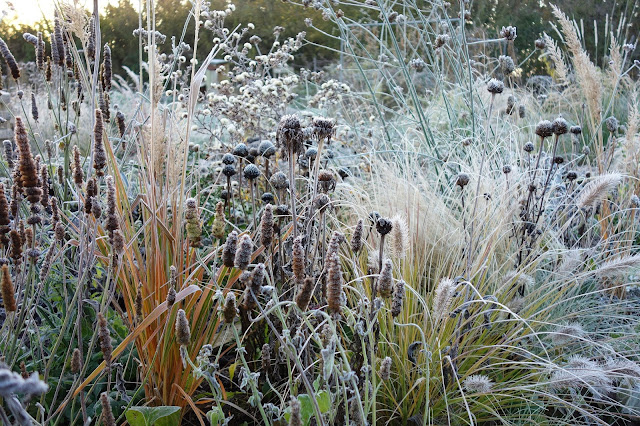 The allotment is not looking bare yet with seed heads and grasses still standing tall. There were some casualties when we had the heavy snowfall a week ago which broke stems and flattened grasses but most survived.
The allotment is not looking bare yet with seed heads and grasses still standing tall. There were some casualties when we had the heavy snowfall a week ago which broke stems and flattened grasses but most survived.I never really understood why we gardeners often get the advice to cut everything down before winter for the so-called big autumn clean up. This does not really make sense to me as in doing so we deprive birds of an essential food source and insects and other invertebrates of a safe spot to hibernate. One of the best things we can do to help wildlife in our gardens is not being too tidy.
Also, leaving seed heads standing through winter will add another season of interest to our gardens. Seed heads look beautiful on a frosty morning and grasses light up like fireworks in low winter sunshine
Below are some pictures from my allotment, all taken in December this year:
Chinese feather grass (Miscanthus sinensis) is one of the best grasses for winter interest (below).
Aster x frikartii `Mönch` and Achnatherum calamagrostis (below)
Agastache foeniculum is silhouetted against the sun (below).
Seed head of Pennisetum alopecuroides (below).
Seed heads and grasses are glowing in the low winter sunshine (below).
Fluffy seed heads of Miscanthus sinensis (below).
My little allotment robin eyeing up the suet block (below).
Seed head of Eupatorium purpureum (below).
Festuca glauca, Ameria maritima and Festuca amethystina growing on the sandy hill near the pond (below).
Wild bergamot (Monarda fistulosa) surrounded by grasses (below).
The grass Anemanthele lessoniana has turned a wonderful orange-red colour (below).
The pompom-like seed heads of Wild bergamot (below).
The last flower of Rudbeckia laciniata (below).
Teasel seed heads backlit by the low winter sun (below).
The allotment on a sunny December day (below).
More grasses with Calamagrostis brachytricha, Calamagrostis x acutiflora 'Karl Foerster' and Eragrostis elliottii (below).
This great tit is busy eating from a piece of suet block (below).
View from the front towards the middle of the allotment (below).
There is still some colour left on the allotment with red and green-coloured swiss chard (below).
The delicate seed heads of Mexican feathergrass (Nassella tenuissima, below).
Giant feathergrass (Stipa gigantea) glowing in the sunshine (below).
Winter rosette of Digitalis ferruginea (below).
Anise hyssop (Agastache foeniculum, below).
Some Asters such as this Symphyotrichum novi-belgii (below) turn a beautiful orange-red colour in autumn.
The robin following me around the allotment in hope for any worms I might bring to the soil surface (below).
The fluffy seed heads of Aster pyrenaeus `Lutetia` (below).
The little blue tit is getting a chance to eat some suet as the robin and great tits are busy elsewhere (below).
Frosted Miscanthus sinensis seed heads (below). This grass comes into growth quite late in spring but once it gets going it is unstoppable and still looks good in winter (below).
A frosty morning on the allotment with Anemanthele lessoniana and Eragrostis elliottii in the foregound (below).
Frozen Rudbeckia laciniata flower (below).
Anemanthele lessoniana with its orange-red leaves always brings some colour to the winter garden (below).
Seed heads galore with Agastache foeniculum, Calamagrostis brachytricha, Echinacea purpurea, Symphyotrichum novi-belgii and Pennisetum alopecuroides (below).
Fragrant aster (Symphyotrichum oblongifolium) starts flowering in early autumn and only stops after the first sharp frosts in November or December (below).
Some Miscanthus sinensis varieties have wonderful red autumn colour (below).
Frosted harebell flower (Campanula rotundifolia, below). Harebells are pretty little plants, flowering on and off for most of the year with a peak in early summer. They need some sunshine and do not like being over-shadowed by taller plants but are otherwise quite undemanding.







































No comments:
Post a Comment